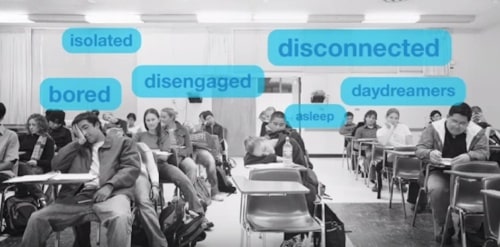Teaching by Asking Instead of Telling
By Laurel Schmidt
Kids don’t have to be in the gifted club or even wide awake to answer most of the questions their teachers pose. In fact, the level of dialogue in some classrooms is so rudimentary that many bright kids have completely abandoned the notion of school as a cerebral experience. That’s why in many classrooms you encounter the phenomenon of the DA—the Designated Answerer—whose single purpose is to answer any question the teacher asks. DA’s spend most of the day with their arms in an aerial position, waiting expectantly, cooperatively, even slavishly, to field the next volley.
 What’s the capital of Iowa?
What’s the capital of Iowa?
Des Moines!
What is the major export of Alaska?
Oil!
What do pandas eat?
Bamboo!
Some classrooms have just one DA, tirelessly playing verbal ping-pong with the teacher from early morning through the closing bell. Other rooms are DA-rich, with three or even four contenders semaphoring vigorously to catch the teacher’s eye, all for the honor of delivering the ‘right’ answer, so the game can move on to the next round.
 And where are the rest of the students? AWOL. Having a rich fantasy life. Working on a series of Baroque doodles or drafting the great American novel, one clandestine note at a time. They’re bored. Indifferent. Ripe for rebellion. And can you blame them? The teacher has made it clear that their presence is only required so the body count matches the attendance sheet. Participation is strictly optional—maybe even unwelcome from students with inquisitive minds or an argumentative streak. And that’s fine with them. School is simply a rehearsal for retirement, without the cane or walker.
And where are the rest of the students? AWOL. Having a rich fantasy life. Working on a series of Baroque doodles or drafting the great American novel, one clandestine note at a time. They’re bored. Indifferent. Ripe for rebellion. And can you blame them? The teacher has made it clear that their presence is only required so the body count matches the attendance sheet. Participation is strictly optional—maybe even unwelcome from students with inquisitive minds or an argumentative streak. And that’s fine with them. School is simply a rehearsal for retirement, without the cane or walker.
It’s not a pretty picture but it’s pretty accurate. Too many schools and instructional programs that tout critical thinking seem to be fundamentally critical of thinking as a basic classroom activity. It takes a long time. It’s messy. The outcomes are uncertain. And how do you assess something that has no right answer? The instructional day is so crowded with ‘experts’, from text books and videos to prescribed, scripted, time-driven curriculum that there’s simply no place for students or teachers to say, “Wait a minute, I don’t think I agree. Let’s take a closer look at that.”
 But what if teachers do want to dig in and try some rigorous thinking? Really probe kids to find out what they’re wondering besides Is it lunchtime yet? They’re not likely to get many takers. Any kid who’s old enough to tie his shoes without assistance is too savvy to play that game because from the first day of kindergarten, we teach kids how to do school. The teacher asks a question. It has one answer. He already has that answer, but he wants to hear it from a kid. In return for the right answer, the respondent will get a smile or perfunctory “that’s right.” After a bit more lecturing, the class will get another question to answer. That’s how you do school, and woe unto the student who gives the wrong answer, or worse, asks a question back! Questions posed by students frequently earn the curt reply, “We’re not talking about that now.”
But what if teachers do want to dig in and try some rigorous thinking? Really probe kids to find out what they’re wondering besides Is it lunchtime yet? They’re not likely to get many takers. Any kid who’s old enough to tie his shoes without assistance is too savvy to play that game because from the first day of kindergarten, we teach kids how to do school. The teacher asks a question. It has one answer. He already has that answer, but he wants to hear it from a kid. In return for the right answer, the respondent will get a smile or perfunctory “that’s right.” After a bit more lecturing, the class will get another question to answer. That’s how you do school, and woe unto the student who gives the wrong answer, or worse, asks a question back! Questions posed by students frequently earn the curt reply, “We’re not talking about that now.”
This is a graveyard for thinkers.
Enter Socrates, who firmly believed that learning could not be delivered, only provoked. Supposedly he said, I can’t teach anyone anything, I can only make them think. And he did that by asking great questions.
This approach to learning is called inquiry and it’s all about dynamism—probing, eliciting, pressing for, searching, seeking, scrutinizing. It’s an interactive, give-and-take-ish way to pursue learning that’s the opposite of the didactic approach, where the teacher delivers large shipments of information to students who are apparently ‘learning’. In reality, many students simply gaze in the approximate direction of the speaker and silently refuse delivery.
So how would one recognize inquiry in the flesh? Questions are a major feature, but unlike the didactic approach, inquiry teachers specialize in open-ended questions which cannot be answered with a simple yes or no. On the contrary, inquiry questions have many possible answers and it’s the teacher’s goal to seek them out, driven by authentic curiosity about what students are actually thinking.
 The structure of an inquiry discussion is relatively simple. The teacher asks an open-ended question and solicits many responses to the same question. Then comes a follow-up question to probe thinking. Finally, the teacher may Insert relevant expert knowledge that students can’t or don’t know but need in order to build on their thoughts. And then it starts all over again. A new question that will move the discussion to the next level.
The structure of an inquiry discussion is relatively simple. The teacher asks an open-ended question and solicits many responses to the same question. Then comes a follow-up question to probe thinking. Finally, the teacher may Insert relevant expert knowledge that students can’t or don’t know but need in order to build on their thoughts. And then it starts all over again. A new question that will move the discussion to the next level.
Here’s the problem. Inquiry is messy. It takes more time and is harder to assess than a read-the-chapter-and-answer-the-questions approach. Plus, it’s a lot of work for teachers, demanding mastery of the subject matter along with rigorous planning in order to craft a logical sequence of questions. And then the teacher must surrender to the process, embracing flexibility and a willingness to respond in the moment to students’ emerging queries and discoveries.
 But here’s the good news. While teachers have to work hard, students have to work even harder. Inquiry questions catapult kids out of their La-Z-Boys. Faced with a single substantive question that seems to have lots of answers, their brains kick in like the search engine on a computer. What do I know about this? Signals go out in every direction. Synapses crackle. The hunt is on and it looks different in every head. One student is searching for facts while another thinks in pictures. Some dredge up personal experiences, others work from logic or extrapolate from parallel situations. The point is, they’re all on task, rooting around in their heads for details, examples, evidence, ideas, theories and speculations. The teacher listens, thinks and asks another question and perhaps another to push students’ thinking. The result is that kids get smarter through their own efforts. They construct meaning by interacting with others, rather than waiting in a persistent vegetative state for another delivery of information.
But here’s the good news. While teachers have to work hard, students have to work even harder. Inquiry questions catapult kids out of their La-Z-Boys. Faced with a single substantive question that seems to have lots of answers, their brains kick in like the search engine on a computer. What do I know about this? Signals go out in every direction. Synapses crackle. The hunt is on and it looks different in every head. One student is searching for facts while another thinks in pictures. Some dredge up personal experiences, others work from logic or extrapolate from parallel situations. The point is, they’re all on task, rooting around in their heads for details, examples, evidence, ideas, theories and speculations. The teacher listens, thinks and asks another question and perhaps another to push students’ thinking. The result is that kids get smarter through their own efforts. They construct meaning by interacting with others, rather than waiting in a persistent vegetative state for another delivery of information.
 You may be thinking that inquiry was a great idea in ancient Athens where people like Socrates had time on their hands and servants to tidy up after them. Whereas, teachers are alone on the front lines of the education battle, with jumbo-sized helpings of responsibility and little support. Probing questions and long answers require time that they don’t have. It takes patience, which may also be in short supply. Plus, teachers using the inquiry method must attend to every word their students utter, and evaluate both the articulation and the thinking behind it. That’s a hell of a lot more work than asking Who was the fourth president of the United States?
You may be thinking that inquiry was a great idea in ancient Athens where people like Socrates had time on their hands and servants to tidy up after them. Whereas, teachers are alone on the front lines of the education battle, with jumbo-sized helpings of responsibility and little support. Probing questions and long answers require time that they don’t have. It takes patience, which may also be in short supply. Plus, teachers using the inquiry method must attend to every word their students utter, and evaluate both the articulation and the thinking behind it. That’s a hell of a lot more work than asking Who was the fourth president of the United States?
So why use the inquiry method? Because school should never be a rehearsal for retirement. It is the incubator where the next generation of citizens is being nurtured. Where the future is taking shape. Commenting on the state of the world in his recent article Navigating Chaos, Thom Markham argued, “Events mandate that education speed up its transformation from a system of compliance to a problem-solving enterprise. Time to insist on helping students learn to engage in complex problem solving by moving daily work in the direction of inquiry, questioning, challenge, and defense.”
 Training in the inquiry method conditions the brain to raise basic issues, probe beneath the surface of things and pursue problematic areas of thought. It also helps students:
Training in the inquiry method conditions the brain to raise basic issues, probe beneath the surface of things and pursue problematic areas of thought. It also helps students:
• Develop sensitivity to clarity, accuracy and relevance in the thoughts, arguments and writing of other people.
• Arrive at judgments through their own reasoning
• Adopt a penetrating and rigorous approach to topics from literature to political science.
Prolonged exposure to inquiry teaches kids how to think in situations outside of school, to greet life with curiosity and healthy skepticism. So, it’s possible that using the inquiry method may be one of the greatest contributions you can make to individual students and society. Why? Because real life is not a true/false or multiple choice test. It’s a series of critical judgments, from How fast can I drive on rain-slickened streets? to How will I choose between six candidates running for the same office? Inquiry equips kids for life. Can you think of a better way to spend your time?
Author
Further Reading
- Anderson Independent Mail – Technology changing the way students learn
- Asheville Citizen Times – New ‘lab school’ planned in Jackson County
- SC Now – Florence School District Two, where students are fully engaged
